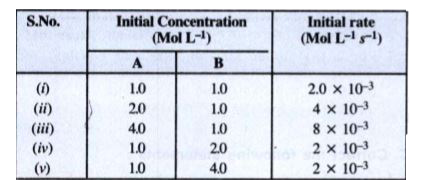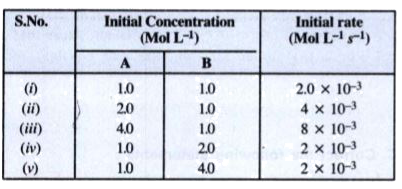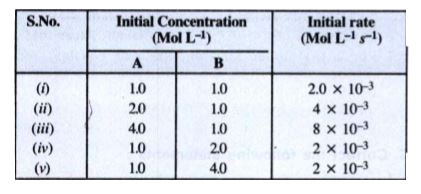In a reaction between A and B, the initial rate of reaction was measured for different initial concentrations of A and B as given below:

What is the order of reaction with respect to A and B ?
r0=k[A]x[B]y
Topper's Solved these Questions
- SELF ASSESSMENT PAPER 7BOOK - ICSECHAPTER - SELF ASSESSMENT PAPER 7EXERCISE - Questions (Complete the following statements by selecting the correct alternative from the choice given : )
4 Videos
- SELF ASSESSMENT PAPER 1BOOK - ICSECHAPTER - SELF ASSESSMENT PAPER 1EXERCISE - QUESTIONS
43 Videos
- SELF ASSESSMENT PAPER-8BOOK - ICSECHAPTER - SELF ASSESSMENT PAPER-8EXERCISE - QUESTIONS
11 Videos
Similar Questions
Consider the reaction, A+B→C+D.
The initial rate for different initial concentrations of the reactants are given below :

Calculate the rate constant.
View SolutionConsider the reaction, A+B→C+D.
The initial rate for different initial concentrations of the reactants are given below :

What are the orders with respect to A and B ?
View SolutionConsider the reaction, A+B→C+D.
The initial rate for different initial concentrations of the reactants are given below :

What are the orders with respect to A and B ?
View SolutionConsider the reaction, A+B→C+D.
The initial rate for different initial concentrations of the reactants are given below :

What is the overall order ?
View SolutionConsider the reaction, A+B→C+D.
The initial rate for different initial concentrations of the reactants are given below :

What is the overall order ?
View SolutionConsider the reaction, A+B→C+D.
The initial rate for different initial concentrations of the reactants are given below :

What is the overall order ?
View SolutionFor the reaction A+B→C+D, the initial rate for different reactions and initial concentration of reactants are given below:

(i) What is the overall order of reaction ?
(ii) Write the rate law equation.
View SolutionThe half life for a given reaction was doubled as the initial concentration of a reactant was doubled. What is the order of reaction.
View SolutionConsider the reaction, A+B→C+D.
The initial rate for different initial concentrations of the reactants are given below :

Write the rate law equation.
View SolutionConsider the reaction, A+B→C+D.
The initial rate for different initial concentrations of the reactants are given below :

Write the rate law equation.
View Solution
